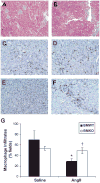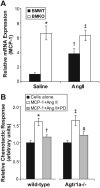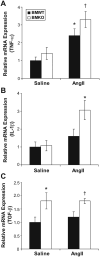A role for angiotensin II type 1 receptors on bone marrow-derived cells in the pathogenesis of angiotensin II-dependent hypertension
- PMID: 19996062
- PMCID: PMC3676183
- DOI: 10.1161/HYPERTENSIONAHA.109.144964
A role for angiotensin II type 1 receptors on bone marrow-derived cells in the pathogenesis of angiotensin II-dependent hypertension
Abstract
Activation of type 1 angiotensin (AT(1)) receptors causes hypertension, leading to progressive kidney injury. AT(1) receptors are expressed on immune cells, and previous studies have identified a role for immune cells in angiotensin II-dependent hypertension. We, therefore, examined the role of AT(1) receptors on immune cells in the pathogenesis of hypertension by generating bone marrow chimeras with wild-type donors or donors lacking AT(1A) receptors (BMKO). The 2 groups had virtually identical blood pressures at baseline, suggesting that AT(1) receptors on immune cells do not make a unique contribution to the determination of baseline blood pressure. By contrast, in response to chronic angiotensin II infusion, the BMKOs had an augmented hypertensive response, suggesting a protective effect of AT(1) receptors on immune cells with respect to blood pressure elevation. The BMKOs had 50% more albuminuria after 4 weeks of angiotensin II-dependent hypertension. Angiotensin II-induced pathological injury to the kidney was similar in the experimental groups. However, there was exaggerated renal expression of the macrophage chemokine monocyte chemoattractant protein 1 in the BMKO group, leading to persistent accumulation of macrophages in the kidney. This enhanced mononuclear cell infiltration into the BMKO kidneys was associated with exaggerated renal expression of the vasoactive mediators interleukin-1beta and interleukin-6. Thus, in angiotensin II-induced hypertension, bone marrow-derived AT(1) receptors limited mononuclear cell accumulation in the kidney and mitigated the chronic hypertensive response, possibly through the regulation of vasoactive cytokines.
Figures





Comment in
-
Angiotensin II type 1a-deficient bone marrow-derived dendritic cells produce higher levels of monocyte chemoattractant protein 1.Hypertension. 2010 Jul;56(1):e6-7; author reply e8. doi: 10.1161/HYPERTENSIONAHA.110.153205. Epub 2010 Jun 1. Hypertension. 2010. PMID: 20516391 No abstract available.
References
-
- Brunner HR, Laragh JH, Baer L, Newton MA, Goodwin FT, Krakoff LR, Bard RH, Buhler FR. Essential hypertension: renin and aldosterone, heart attack and stroke. N Engl J Med. 1972;286:441–449. - PubMed
-
- Gavras H, Lever AF, Brown JJ, Macadam RF, Robertson JI. Acute renal failure, tubular necrosis, and myocardial infarction induced in the rabbit by intravenous angiotensin II. Lancet. 1971;2:19–22. - PubMed
-
- Crowley SD, Tharaux PL, Audoly LP, Coffman TM. Exploring type I angiotensin (AT1) receptor functions through gene targeting. Acta Physiol Scand. 2004;181:561–570. - PubMed
-
- Dahlof B, Devereux RB, Kjeldsen SE, Julius S, Beevers G, de Faire U, Fyhrquist F, Ibsen H, Kristiansson K, Lederballe-Pedersen O, Lindholm LH, Nieminen MS, Omvik P, Oparil S, Wedel H. Cardiovascular morbidity and mortality in the Losartan Intervention for Endpoint Reduction in Hypertension Study (LIFE): a randomised trial against atenolol. Lancet. 2002;359:995–1003. - PubMed
Publication types
MeSH terms
Substances
Grants and funding
LinkOut - more resources
Full Text Sources
Medical
Research Materials

